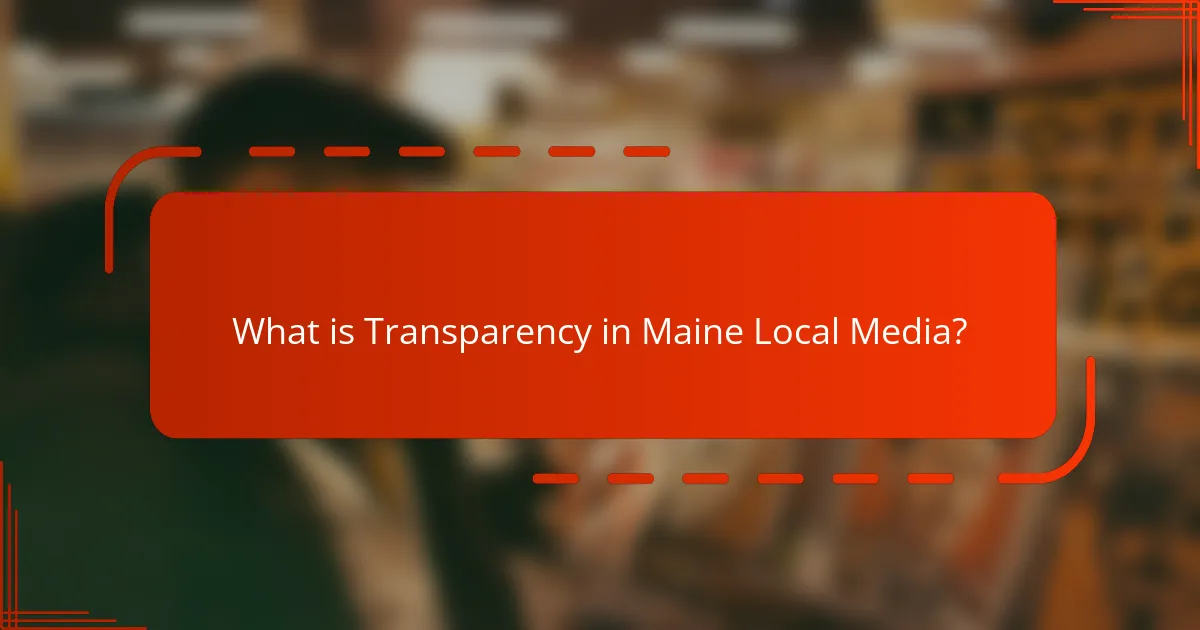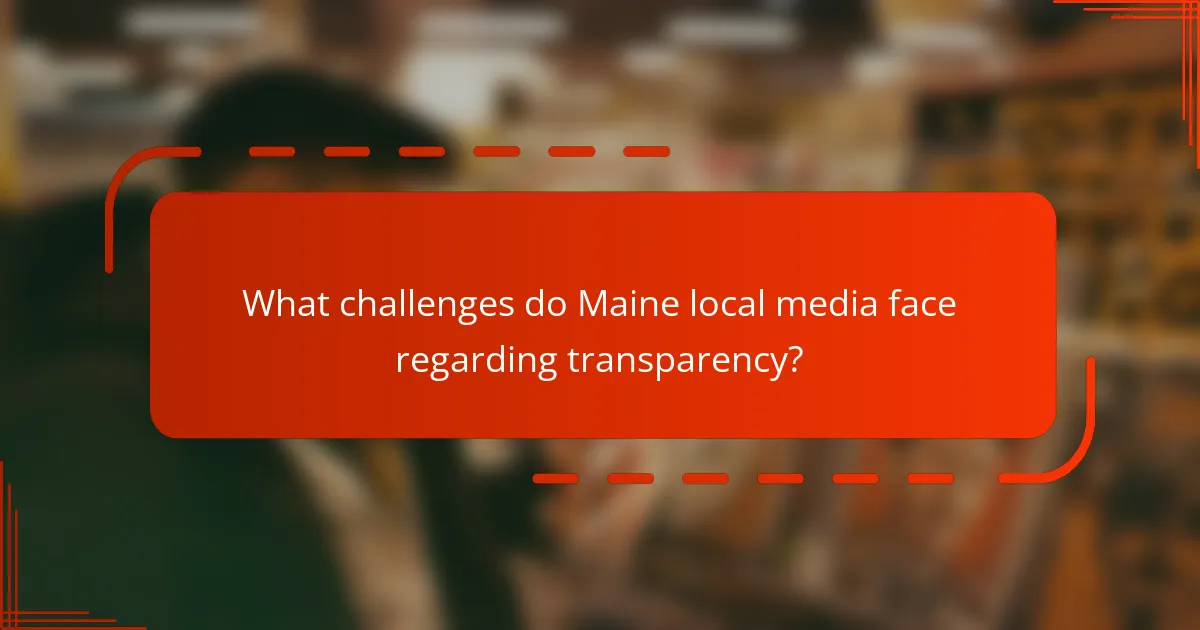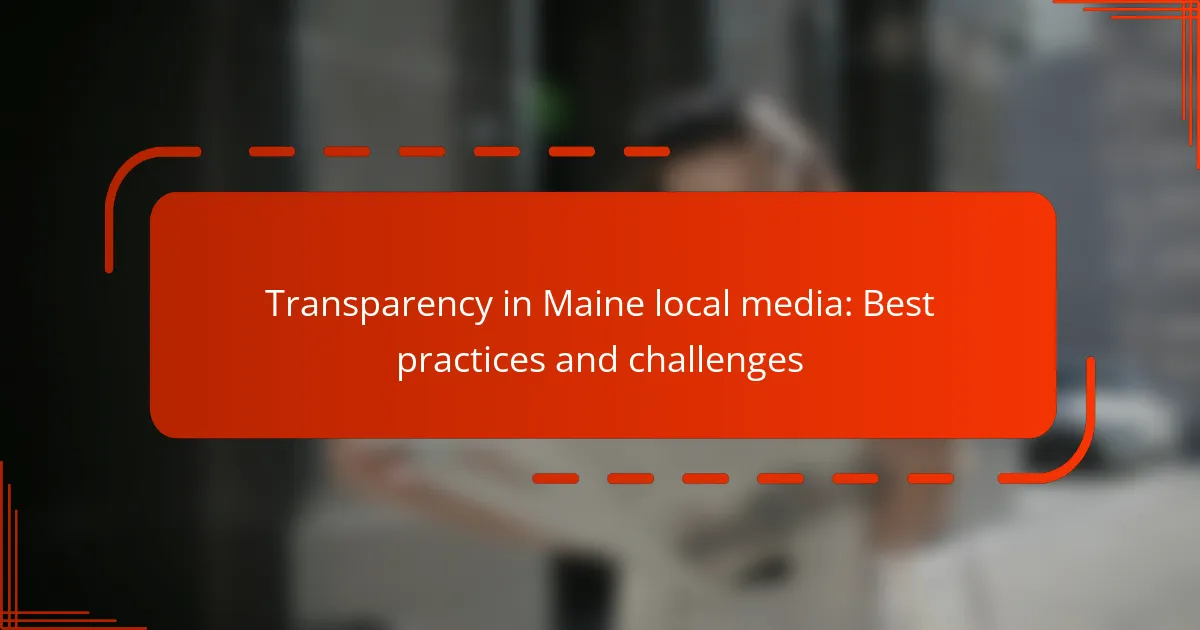Transparency in Maine local media is characterized by the openness and clarity of media organizations regarding their ownership, funding sources, and editorial policies. This article examines best practices for enhancing transparency, such as disclosing financial information and engaging with the community, which help build trust and accountability in journalism. It also addresses significant challenges faced by local media, including limited access to public records and financial constraints, which impact their ability to investigate and report effectively. The discussion highlights the importance of transparency in fostering an informed citizenry and maintaining the integrity of media institutions.

What is Transparency in Maine Local Media?
Transparency in Maine local media refers to the clarity and openness with which media organizations operate. It involves disclosing ownership, funding sources, and editorial policies. Transparency allows the public to understand potential biases and conflicts of interest. In Maine, some local media outlets have adopted practices to enhance transparency. For example, they may publish financial reports and provide information about their governance structures. These efforts help build trust between media organizations and their audiences. Transparency is crucial for maintaining accountability in journalism. It empowers citizens to make informed decisions based on reliable information.
Why is transparency important in local media?
Transparency is important in local media because it builds trust between the media and the community. Trust is essential for effective communication and engagement. When local media outlets are transparent, they provide clear information about their sources, funding, and editorial processes. This clarity allows audiences to understand the context and credibility of the news they consume. Studies show that communities with transparent media have higher levels of civic participation and informed citizenship. Furthermore, transparency can lead to accountability, as media organizations are held responsible for their reporting practices. In Maine, local media that prioritize transparency can foster stronger relationships with their audiences and enhance public discourse.
How does transparency impact public trust in media?
Transparency significantly enhances public trust in media. When media organizations are open about their processes, funding, and decision-making, audiences feel more assured of their integrity. Research indicates that 78% of Americans believe transparency is crucial for trust in news sources. Clear disclosure of sources and methodologies fosters credibility. Moreover, transparency helps to mitigate misinformation and bias, reinforcing the media’s role as a reliable information provider. A 2021 study by the Pew Research Center found that transparency initiatives led to increased trust levels among consumers. Overall, transparent practices are essential for building and maintaining public confidence in media.
What role does transparency play in journalism ethics?
Transparency is crucial in journalism ethics as it fosters trust between journalists and their audience. It ensures accountability by allowing the public to understand how information is gathered and reported. Transparent practices include disclosing sources, funding, and potential conflicts of interest. This openness helps prevent misinformation and bias. According to the Society of Professional Journalists, transparency enhances credibility and encourages responsible reporting. Ethical journalism relies on clear communication about the processes involved in news production. Ultimately, transparency serves as a foundation for a healthy democratic society by empowering informed citizens.
What are the key principles of transparency in media?
The key principles of transparency in media include accountability, openness, and clarity. Accountability ensures that media organizations take responsibility for their content and actions. Openness involves sharing information about sources, funding, and decision-making processes. Clarity focuses on presenting information in a straightforward manner, avoiding jargon that may confuse the audience. Together, these principles foster trust between media outlets and their audiences. Transparency in media has been shown to improve credibility, as evidenced by studies indicating that audiences are more likely to trust outlets that adhere to these principles.
What does accountability mean in the context of local media?
Accountability in the context of local media refers to the responsibility of media organizations to provide accurate, fair, and transparent reporting. This includes adhering to ethical standards and being answerable to the public for their content. Local media must ensure that they verify information before publication. They should also correct errors promptly and transparently. Accountability fosters trust between media outlets and their audience. Studies show that communities with accountable media report higher levels of public engagement. This engagement is crucial for a functioning democracy. Local media can enhance accountability by implementing clear editorial policies. These policies guide their reporting practices and address conflicts of interest.
How does openness contribute to transparency?
Openness enhances transparency by fostering clear communication and accessibility of information. When organizations adopt an open approach, they encourage the sharing of data and decision-making processes. This practice allows stakeholders to understand actions and motivations clearly. For instance, when local media in Maine openly disclose their funding sources, it builds trust with the audience. Transparency is further reinforced as openness invites public scrutiny and feedback. This dynamic creates a more informed community that can engage in meaningful dialogue. Ultimately, openness acts as a foundational principle that supports the integrity and accountability of transparent practices.

What are the best practices for achieving transparency in Maine local media?
The best practices for achieving transparency in Maine local media include clear disclosure of funding sources and affiliations. Media outlets should openly share information about their ownership and any potential conflicts of interest. Regularly publishing editorial guidelines can help establish trust with the audience. Engaging with the community through public forums or social media enhances accountability. Providing detailed reporting on local issues fosters an informed citizenry. Training journalists on ethical standards promotes integrity in reporting. Utilizing fact-checking resources ensures accuracy in news dissemination. Collaboration with other local media can also enhance transparency and resource sharing.
How can local media outlets enhance their transparency?
Local media outlets can enhance their transparency by implementing clear editorial policies. These policies should outline how news is gathered and reported. Transparency in sourcing is crucial; outlets must disclose their sources when possible. Regularly publishing financial information can also build trust with the community. Engaging with the audience through open forums increases accountability. Training staff on ethical journalism promotes integrity in reporting. Additionally, using social media to communicate openly about decisions can foster trust. According to a 2021 Pew Research study, transparency efforts can significantly improve public perception of media credibility.
What specific strategies can be implemented for better transparency?
Implementing specific strategies for better transparency includes clear communication, regular reporting, and community engagement. Clear communication ensures that information is easily accessible and understandable. Regular reporting on operations and decisions builds trust with the audience. Community engagement through forums or surveys allows the audience to voice concerns and ask questions. Transparency can also be enhanced by publishing financial statements and editorial policies. These practices foster accountability and demonstrate commitment to openness. Studies show that transparent organizations experience higher levels of public trust and credibility.
How can local media engage with their audience to improve transparency?
Local media can engage with their audience to improve transparency by adopting open communication practices. They should regularly share information about their editorial processes and decision-making. This includes explaining how stories are chosen and the sources used. Hosting community forums can also facilitate direct interaction with the audience. Surveys and feedback forms can gather audience opinions on coverage and areas of interest. Utilizing social media platforms for real-time updates enhances accessibility and direct engagement. Additionally, publishing corrections and clarifications demonstrates accountability. Research indicates that transparency builds trust, which is critical for local media credibility.
What tools and technologies support transparency in media?
Blockchain technology supports transparency in media by providing immutable records of content creation and distribution. This ensures accountability and traceability of information sources. Fact-checking tools enhance transparency by verifying the accuracy of news articles. Platforms like PolitiFact and Snopes provide reliable assessments of claims made in media. Open-source software fosters transparency by allowing users to inspect and modify code, ensuring the integrity of media platforms. Data visualization tools help present information clearly, enabling audiences to understand complex data. Social media analytics tools track engagement and audience reactions, providing insights into public perception. These technologies collectively promote transparency in media operations and content dissemination.
What role does social media play in promoting transparency?
Social media plays a crucial role in promoting transparency by enabling real-time communication and information sharing. It allows individuals and organizations to share updates, decisions, and data directly with the public. This immediacy fosters accountability, as stakeholders can easily access information and engage in discussions. Studies show that transparency increases public trust. For instance, a survey by the Pew Research Center indicates that 64% of Americans believe social media helps them stay informed about government actions. Furthermore, social media platforms provide a space for whistleblowers and citizens to report issues, amplifying voices that might otherwise go unheard.
How can data journalism contribute to transparent reporting?
Data journalism enhances transparent reporting by utilizing data to support claims and narratives. It allows journalists to present information in a clear and factual manner. Through the analysis of datasets, journalists can uncover trends and patterns that inform the public. This method promotes accountability by providing evidence for statements made in news articles. For example, data visualizations can illustrate complex information, making it accessible to a broader audience. Furthermore, data journalism encourages the verification of information, reducing reliance on unverified sources. According to a study by the Tow Center for Digital Journalism, data-driven reporting increases public trust in news organizations. Thus, data journalism plays a crucial role in fostering transparency in media.

What challenges do Maine local media face regarding transparency?
Maine local media face significant challenges regarding transparency. One major issue is limited access to public records. Journalists often encounter bureaucratic hurdles when requesting information. This can lead to delays or denials in obtaining necessary data. Additionally, financial constraints affect local media’s ability to investigate thoroughly. Many outlets operate with reduced staff and resources. This limits their capacity to hold public officials accountable. Furthermore, there is a growing distrust in media institutions. This skepticism can hinder transparency efforts, as audiences may question the motives behind reporting. These challenges collectively impact the effectiveness of local media in promoting transparency.
What barriers exist to achieving transparency in local media?
Barriers to achieving transparency in local media include financial constraints, lack of resources, and limited access to information. Local media organizations often operate on tight budgets, which restricts their ability to invest in investigative journalism. Additionally, many local news outlets have small staff sizes, limiting their capacity to cover complex issues thoroughly.
Access to public records can also be a significant challenge. Many local governments may not have efficient systems for information dissemination. This can hinder journalists’ ability to obtain necessary data for reporting. Furthermore, there may be a culture of secrecy within some local institutions, discouraging openness.
Public trust issues can further complicate transparency efforts. If the community perceives local media as biased or untrustworthy, they may be less likely to engage with or support these outlets. This lack of trust can diminish the media’s role as a watchdog.
Overall, financial limitations, resource scarcity, access challenges, institutional secrecy, and trust issues collectively hinder transparency in local media.
How do financial constraints affect transparency efforts?
Financial constraints significantly hinder transparency efforts in local media. Limited budgets restrict resources available for investigative journalism. This often leads to reduced staffing and fewer in-depth reporting opportunities. Consequently, important issues may go unreported or inadequately covered. Financial pressures can also result in reliance on cheaper, less reliable sources of information. A study by the Pew Research Center found that nearly 70% of local newsrooms reported budget cuts affecting their ability to cover critical community issues. This illustrates how financial limitations directly impact the quality and quantity of transparency in local media.
What influence do political pressures have on media transparency?
Political pressures can significantly hinder media transparency. These pressures may lead to censorship or biased reporting. Journalists may avoid covering certain topics due to fear of backlash. In Maine, political influences can shape local media narratives. For instance, funding from political entities can affect editorial independence. Studies show that media outlets under political influence often prioritize certain viewpoints. This compromises the integrity of information presented to the public. Consequently, the audience may receive a distorted view of events and issues.
How can local media address challenges to transparency?
Local media can address challenges to transparency by implementing clear communication strategies. They should prioritize fact-checking and provide context for complex issues. Utilizing accessible language helps engage the community effectively. Regularly publishing data and reports fosters accountability. Establishing feedback channels encourages public participation and trust. Collaborating with local organizations can enhance credibility. Training staff on ethical journalism practices is essential for maintaining integrity. These measures can significantly improve transparency and public trust in local media.
What collaborative efforts can be made to overcome these challenges?
Collaborative efforts to overcome challenges in transparency in Maine local media include partnerships between media organizations and community groups. Media outlets can work with local nonprofits to foster open dialogue and share resources. Training programs can be developed to enhance journalistic standards and ethics. Collaborations with educational institutions can provide internships and practical experience for aspiring journalists. Joint initiatives can be launched to promote media literacy among the public. These efforts can help build trust and accountability in local media. Studies show that community engagement improves transparency and fosters a more informed citizenry.
How can training and education improve transparency in journalism?
Training and education improve transparency in journalism by equipping journalists with essential skills and ethical standards. These programs teach the importance of sourcing information accurately. They emphasize fact-checking and verification processes. Journalists learn to disclose conflicts of interest and maintain accountability. Training promotes understanding of legal and ethical responsibilities in reporting. Research shows that educated journalists are more likely to adhere to transparency practices. For instance, a study by the Pew Research Center highlights that 77% of journalists believe training enhances their reporting integrity. This foundation fosters trust between media organizations and the public.
What practical tips can enhance transparency in local media?
Enhancing transparency in local media can be achieved through several practical tips. First, local media outlets should provide clear information about their funding sources. This helps audiences understand potential biases. Second, publishing editorial policies can clarify how news is gathered and reported. Third, engaging with the community through public forums promotes open dialogue. Fourth, providing access to internal communications can build trust. Fifth, implementing fact-checking processes ensures accuracy in reporting. Lastly, collaborating with independent watchdog organizations can enhance credibility. These practices align with the principles of transparency, fostering a more informed public.
How can media outlets create a culture of transparency within their teams?
Media outlets can create a culture of transparency by implementing open communication practices. Regular team meetings encourage sharing of information and ideas. Establishing clear guidelines for reporting and decision-making fosters trust among team members. Providing access to internal documents and processes promotes accountability. Training staff on ethical journalism reinforces the importance of transparency. Encouraging feedback from team members helps identify areas for improvement. These practices align with the principles of transparency outlined in the Society of Professional Journalists’ Code of Ethics, which emphasizes honesty and integrity in journalism.
What resources are available for local media to improve transparency practices?
Local media can access several resources to improve transparency practices. The Institute for Nonprofit News offers training and guidelines. The American Press Institute provides resources on best practices for transparency. The Knight Foundation funds projects that enhance journalistic transparency. Additionally, local journalism organizations often host workshops focused on ethical reporting. These resources equip journalists with tools to foster accountability and trust.
Transparency in Maine local media refers to the clarity and openness with which media organizations disclose ownership, funding sources, and editorial policies. This article examines the importance of transparency in building public trust, accountability, and ethical journalism practices. It outlines best practices for enhancing transparency, such as clear communication, community engagement, and the use of technology, while also addressing the challenges local media face, including financial constraints and political pressures. The discussion emphasizes the critical role of transparency in fostering informed citizenship and maintaining credible journalism in Maine.
